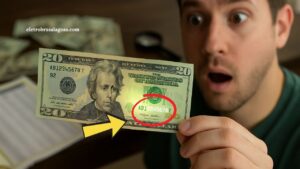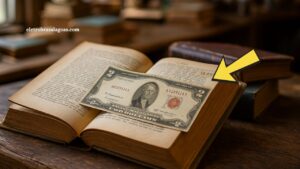What if the old $5 bill tucked inside your wallet or desk drawer was actually worth more than your car? For collectors, that’s a real possibility.
In 2025, interest has surged around 1953 Red Seal $5 bills, particularly those with low serial numbers, which are now fetching prices upward of $100,000.
While most people glance past these vintage bills, collectors are actively seeking specific versions with unique features. Here’s everything you need to know to determine if you’re sitting on a rare and highly valuable piece of U.S. currency.
Why the 1953 Red Seal $5 Bill Is Special
The 1953 Red Seal $5 bill is not your typical currency. Unlike today’s green-seal Federal Reserve Notes, these were part of a unique issuance of United States Notes featuring a red Treasury seal and red serial numbers.
These notes are already interesting to collectors due to their historic significance—but some rare variants have driven their value to staggering levels.
What makes them particularly valuable are:
- Low serial numbers (e.g., 00000001 to 00000099)
- Uncirculated condition (no folds, stains, or wear)
- Unique print errors or exceptional registration
What Your 1953 Red Seal $5 Could Be Worth
| Condition / Feature | Estimated Value Range |
|---|---|
| Circulated, common serial | $5 – $15 |
| Uncirculated, common serial | $40 – $60 |
| Star note (*) | $50 – $100 |
| Uncirculated + Low serial (000000XX) | $10,000 – $100,000+ |
| Serial #00000001 | Up to $120,000 |
What to Look for: Is Your $5 Bill a Jackpot?
If you’ve got a 1953 Red Seal $5 bill, here’s how to evaluate its potential:
1. Serial Number
- The most valuable notes have ultra-low serial numbers—typically starting with multiple zeros, such as 00000025 or even 00000001.
- Numbers like 00000009 or 00000077 are also in high demand.
2. Series and Seal
- Ensure the bill is from 1953, 1953A, 1953B, or 1953C.
- It must feature a red seal and red serial numbers (not green).
3. Condition (Grading)
- Uncirculated notes (graded as CU or Gem CU) carry the highest values.
- Even circulated bills can fetch more if the serial number is extremely low.
4. Star Notes
- These notes have a ★ symbol in place of the suffix letter (e.g., *A).
- While collectible, they’re generally worth less than low-serial regular notes.
Why Are These Notes Worth So Much?
Rarity + Condition = Value
- Only a limited number of low serial number notes were ever printed.
- Very few have remained in uncirculated condition over 70+ years.
- Demand among collectors continues to increase as more notes disappear into private collections.
Historical Appeal
- These notes represent one of the last eras of United States Notes before full transition to Federal Reserve Notes.
- The red seal design is no longer used, giving them a nostalgic edge.
What to Do if You Have One
If your bill fits the criteria for high value:
- Do not fold or clean it – This could significantly reduce its value.
- Store it properly – Use a currency sleeve or holder to protect it.
- Get it graded – Professional grading through PCGS Currency or PMG can authenticate and certify the condition.
- Consider auctioning – High-end collectors often purchase through auctions or private sales.
Real-Life Examples of High Sales
While only a few top-dollar notes exist, several examples show how valuable these $5 bills can be:
- A pristine 1953 Red Seal note with serial number 00000009 was sold for over $100,000.
- Bills with serial numbers below 00000100 have fetched $10,000–$60,000, depending on condition and demand.
- Star notes in excellent condition occasionally sell for several hundred dollars.
That old $5 bill in your collection might be worth far more than its face value—especially if it’s a 1953 Red Seal with a rare serial number. With some notes selling for over $100,000, it’s well worth checking the serial number and condition before spending or stashing it away.
Whether you’re a seasoned collector or just curious about that vintage bill in your drawer, now is the time to examine your 1953 Red Seal $5 note. It could be the most valuable piece of paper you’ve ever held.
FAQs
What is a “Red Seal” $5 bill?
It’s a type of U.S. Note issued before Federal Reserve Notes became standard. The red seal and red serial numbers distinguish it from typical currency.
Why are low serial numbers so valuable?
Bills with extremely low serials (like 00000001–00000099) are extremely rare and considered premium collector’s items, especially in mint condition.
Should I grade my 1953 Red Seal $5 bill before selling it?
Yes. Grading provides official confirmation of the note’s authenticity and condition, increasing trust and market value among collectors.




